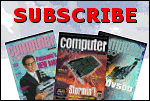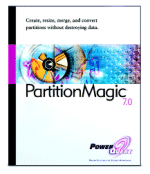|

Inside
the magazine
Self-help message board
Article reprints
How to contact us
Web links directory
Software downloads
Tips and advice
Fire-wire campaign
Subscribe today
Help Me, I'm new!
Fair pricing petition
Home

In
Software Downloads:
Adobe
Premiere 6 (trial)
Paint Shop Pro 7 (trial)
Tips
and Advice:
How to get started with
computer video editing
Fire-wire
Campaign:
Join our ongoing campaign
|
Partitioning
reviews
All Microsoft's
operating systems, from DOS onwards, have used the idea of single letters
to identify disk drives. 'A:' and 'B:' are reserved for two floppy disk
drives, and the first hard-disk drive is 'C:'. Extra hard drives are
identified as 'D:', 'E:', 'F:', and so on.
However, these hard drives are not quite the same as the drive units
that are screwed into the computer. The space on each physical drive
is divided into one or more chunks, called partitions, and the drive
letters actually correspond to partitions, not physical units.
Most new PCs are shipped with one hard drive, configured with a single
partition occupying all the available space, so the possibility of multiple
partitions isn't immediately apparent. It's tempting to describe such
a drive as ënot partitioned', but that's not really true. A drive
letter always corresponds to a partition, even if there is only one
partition on the drive. A drive that really has no partitions - such
as a brand-new one - is not even visible on a PC, except using the operating
system's partitioning tools. This collection of reviews sample some
of what's on offer in the way of tools for creating and managing partitions
on hard drives.
Terabyte Unlimited's
BootIt Next Generation (Bing for short) is shareware, and gives users
the peace-of-mind of being able to try before they buy. It can be used
in a virtually fully functional state for up to 30 days, after which
it must be registered and paid for (US$29.95). The program comes as
a downloadable zip file that's astonishingly small ñ just 468KByte
ñ yet even includes a 35-page manual in PDF format! The company's
web site ñ www.terabyteunlimited.com ñ also hosts on-line
tutorials and has links to an active discussion group where the authors
and experienced users are extremely helpful in answering queries.
 PartitionMagic
has long been the definitive partition manipulation tool. The latest
incarnation, V7.0, is powerful and sophisticated, and the first version
to be compatible with Windows XP. Previous versions of PartitionMagic
can't install correctly under XP and, even if run in DOS mode, do not
recognise XP's flavour of NTFS partitions. With V7, though, installation
on our Windows XP test machine was straightforward and NTFS appeared
not to be a problem. During installation from the auto-start CD, the
user is given the option to create a pair of Rescue Diskettes, one a
boot disk, the other a program disk. Together, these floppies are used
to run PartitionMagic in DOS mode without having to rely on the program
being installed on the hard-disk. PartitionMagic
has long been the definitive partition manipulation tool. The latest
incarnation, V7.0, is powerful and sophisticated, and the first version
to be compatible with Windows XP. Previous versions of PartitionMagic
can't install correctly under XP and, even if run in DOS mode, do not
recognise XP's flavour of NTFS partitions. With V7, though, installation
on our Windows XP test machine was straightforward and NTFS appeared
not to be a problem. During installation from the auto-start CD, the
user is given the option to create a pair of Rescue Diskettes, one a
boot disk, the other a program disk. Together, these floppies are used
to run PartitionMagic in DOS mode without having to rely on the program
being installed on the hard-disk.
A Read-me file is installed at the same time and is accessible via the
Programs menu. The contents are quite extensive and offer various tips,
plus details of known problems. A well-written and comprehensive 150-page
printed manual is also included in-pack.
Drive Image is a companion program to PowerQuest's PartitionMagic, and
creates compressed image files of partitions, as well as copying entire
partitions. Installation from the CD was simple and conventional. Choosing
ëcustom' setup you have the option to install the PDF files of
the manual on disk, as well as a choice of additional drivers to support
Iomega Zip drives, SCSI CD-ROMs, and Fujitsu MO drives.
As with PartitionMagic, you can also create a pair of ëRescue Diskettes'
that allow you to boot and run Drive Image independently of the hard
drive. The 120-page printed manual is again clear and comprehensive.
Ghost 2002 has a lot to live up to, coming as it does from the same
family of well-respected utilities as Norton Antivirus and Norton Utilities.
The CD autoruns on insert and, as well as giving options to install
Ghost and Acrobat reader, offers some interactive tutorials. These walk
through five common types of imaging and copying task, and are quite
useful ñ despite the inclusion of a computer-generated American
female commentary.
There are no significant installation options, and the folder in the
Programs menu contains only two items ñ Ghost Boot Wizard and
Ghost Explorer. The printed manual spans about 120 pages and contains
plenty of detail, but is written in a rather technical style. Ghost
makes no pretence of running under Windows ñ the purpose of the
Boot Wizard program is to create a DOS boot floppy disk that can be
used to boot the computer and run Ghost.
No one of these disk utilities will suit all users but pairing PowerQuest's
PartitionMagic (£41.12) with its sister program, Drive Image (£45.82)
provides the most comprehensive tool kit for backing-up and manipulating
partitions. Partition Magic is the only program here that carries out
most of its work under Windows, making it easy to use and meaning that
it's the only one that can work with FireWire drives.
But, PowerQuest users appear to have no comeback if problems result
in lost or corrupt data on drives larger than 80GByte, whereas the other
programs ñ BootIt NG from Terabyte Unlimited, and Symantec's
Norton Ghost ñ are said to work with any drive that the PC's
Bios can handle. Hopefully future versions of Partition Magic will support
bigger drives but there's no certainty they will. Even if they do, upgrades
are unlikely to offer much of a saving over the full prices.
For copying and imaging partitions, Symantec's Norton Ghost offers a
good alternative to Drive Image. Although it has a quirky user interface
and little Windows integration, it performs well and can be extremely
powerful in the hands of users able to master complex command lines
in batch files. At £37.59 (or £33 as a download), Ghost
is a good bit cheaper than Drive Image.
Despite being shareware and the cheapest product on test (US$29.99/
£21.14), BootIt NG offers all of the important functions required
for manipulating and imaging partitions, and is also a powerful boot
manager. It needs some work to master, but life can be made easier using
free downloadable companion programs that offer a degree of Windows
integration. The program is available for a 30-day free trial, and enhanced
versions, which arrive regularly, are free to registered users. It is
remarkable value and we'd strongly recommend trying it before deciding
on any of the other programs.
Richard Jones
For the full review,
see the April 2002 issue of Computer Video.
|
Recent features...
View
The Archive
Reviewed in April's issue:
Ulead DVD Workshop
Partitioning Reviews
In April's news:
Edit ready Sony Vaios
ADSL price cut
Western Digital
Video Forum 2002
|





 PartitionMagic
has long been the definitive partition manipulation tool. The latest
incarnation, V7.0, is powerful and sophisticated, and the first version
to be compatible with Windows XP. Previous versions of PartitionMagic
can't install correctly under XP and, even if run in DOS mode, do not
recognise XP's flavour of NTFS partitions. With V7, though, installation
on our Windows XP test machine was straightforward and NTFS appeared
not to be a problem. During installation from the auto-start CD, the
user is given the option to create a pair of Rescue Diskettes, one a
boot disk, the other a program disk. Together, these floppies are used
to run PartitionMagic in DOS mode without having to rely on the program
being installed on the hard-disk.
PartitionMagic
has long been the definitive partition manipulation tool. The latest
incarnation, V7.0, is powerful and sophisticated, and the first version
to be compatible with Windows XP. Previous versions of PartitionMagic
can't install correctly under XP and, even if run in DOS mode, do not
recognise XP's flavour of NTFS partitions. With V7, though, installation
on our Windows XP test machine was straightforward and NTFS appeared
not to be a problem. During installation from the auto-start CD, the
user is given the option to create a pair of Rescue Diskettes, one a
boot disk, the other a program disk. Together, these floppies are used
to run PartitionMagic in DOS mode without having to rely on the program
being installed on the hard-disk.